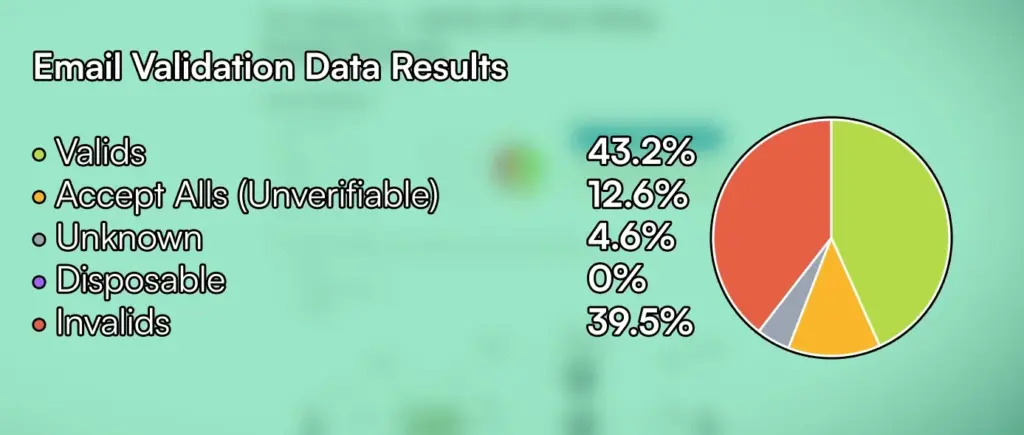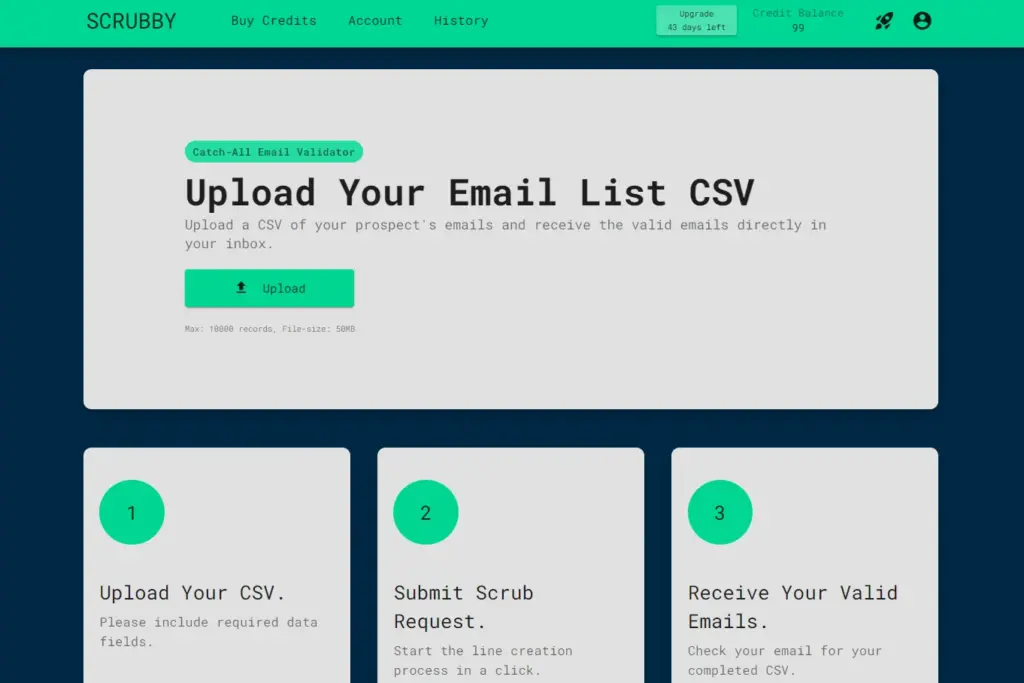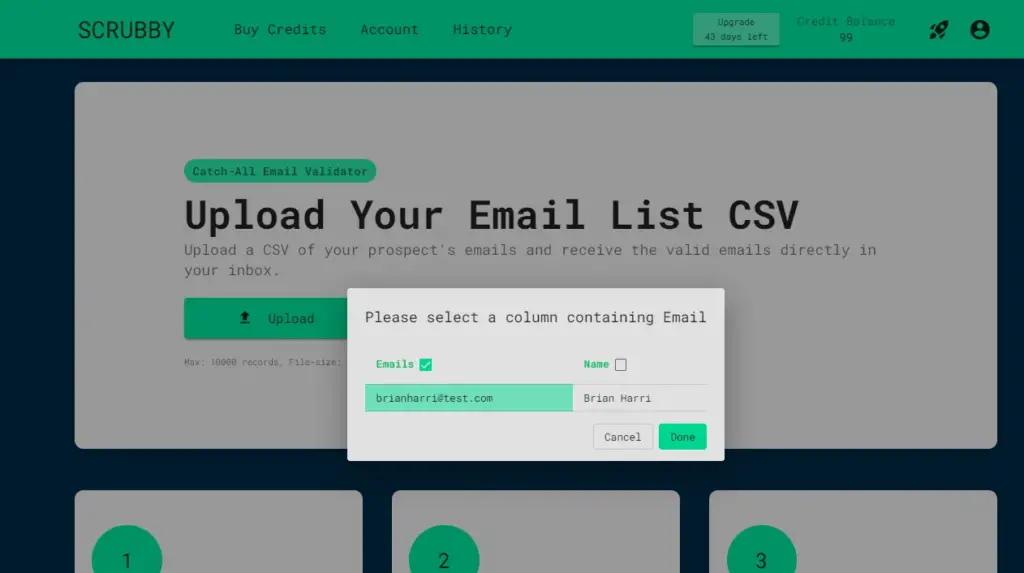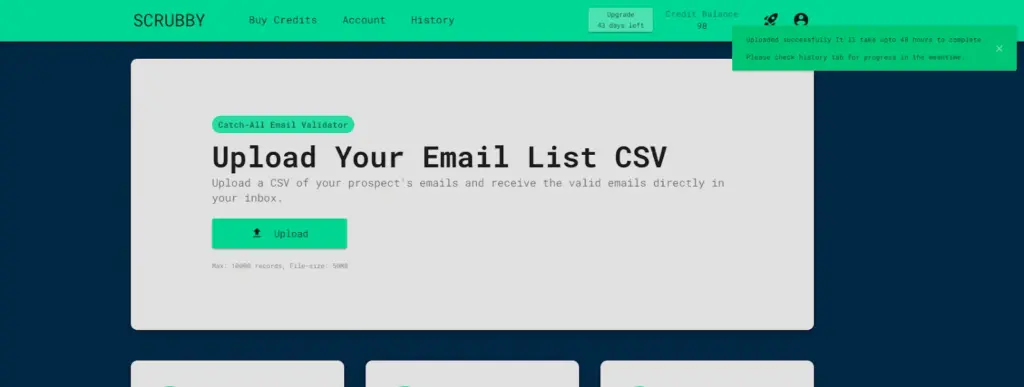If you’ve dived into the world of email marketing, chances are you’ve bumped into terms like accept-all or catch-all email addresses. You might be wondering, what is a catch-all email and how can you verify them?
Here’s the thing. Majority of people either leave out catch-all emails or risk their deliverability by including them. By not verifying catch-all emails. you’re leaving out a whopping 42% of your lead list. In other words, you’re missing out on a ton of money and leads.
Fear not! In this detailed guide, we’ll teach you everything you need to know about what catch-all emails are, why they are important, and a step-by-step breakdown on how to verify catch-all emails (for free and at scale). We’ll also discuss if catch-all emails are safe to include in your campaigns. Using our email verification service, you can verify and validate up to 100 catch-all emails for free. Scrubby is the only email validation tool for catch-all emails that uses burner accounts to hard test and validate your catch-all lead list so you can unlock more leads and close more deals. Let’s dive in.
What is a catch-all email?
A catch-all email, also known as a wildcard or accept-all email, is like a reliable safety net for all your business communications. It’s set up where one email mailbox just grabs or “catches” all the messages sent to a domain, no matter what’s written before the “@” symbol. It’s used to make sure that no emails or important information slips through the cracks.
Yep, it catches everything. Even email addresses that don’t exist or those that might have a little typo or mistake in the address. It’s a pretty neat way to ensure that no important messages get lost in the digital abyss due to minor errors.Let’s say for example your email is info@google.com and it’s configured as a catch-all domain. If someone emailed contact@google.com or information@google.com instead by accident, the email would still reach and land in your main inbox (info@google.com).
Why do companies use catch-all emails?
Businesses may want to configure its domain as a catch-all domain for several reasons.
Preventing email bounces with catch-all emails
- Capture of Wrong Emails: Catch-all emails capture messages sent to incorrect or non-existent addresses, preventing them from bouncing back as undeliverable.
- Safety Net for Users: They provide a safety net for users who might make mistakes when entering email addresses, ensuring that their messages are still delivered.
- Spam Protection: Catch-all emails can also be configured to collect and filter potential spam emails, protecting individual email accounts from clutter and potential security threats.
- Enhancing User Engagement: Catch-all emails enhance user engagement by preventing disruptions in communication due to bounced emails.
Building relationships with users
In the B2B sector, catch-all emails facilitate seamless communication, ensuring that businesses do not miss out on any potential opportunities. They aid in:
- Building Relationships: Catch-all emails facilitate the building of relationships with users by ensuring continuous communication. For example, it allows someone like an eCommerce store to never miss a customer question directed to the support team.
- Potential Business Opportunities: They can turn messages into potential leads and business opportunities, enhancing customer engagement and satisfaction.
- Lead Generation: Catch-all emails can be a valuable tool in lead generation, capturing potential leads that might have been lost due to incorrect email addresses.
However, it’s not all sunshine and rainbows with catch-all emails. A glaring downside is the potential influx of spam emails, as the system accepts all messages, including those sent to non-existent addresses. This can cause a flood of unwanted emails, complicating the task of distinguishing genuine emails from spam.
Why should you verify catch-all emails?
While catch-all email accounts can be beneficial for domain owners in preventing the loss of information, they may not be beneficial for you when you are conducting cold email campaigns.
Traditional methods of email verification often fall short when it comes to validating catch-all emails. These methods generally involve:
- Syntax Verification: Checking the syntax of the email address to ensure it conforms to standard email formats.
- Domain Verification: Verifying the domain to ensure it is valid and capable of receiving emails.
- SMTP Verification: Utilizing SMTP protocols to verify the existence of the mailbox.
In order to understand why you should validate catch-all emails further, let’s first understand how common they are.
1) Catch-all emails make up 42% of your lead list
Most email validation tools on the market (NeverBounce, Zerobounce) use the same underlying technology called SMTP validation.
These email validation tools will split your emails into 3 scenarios: valid emails, invalid emails, and accept/catch-alls.

When you run your email list through these traditional tools, you’ll typically find an average of 40-50% of your email list comes out as valid.
The other 50% is typically classified as invalid or catch-all emails. That my friend, is a huge chunk of your email list that you’re missing out on.
2) Not verifying catch-all emails damage your domain reputation
Are catch-all emails safe to include your campaign? The short answer is no. Including catch-all emails without first verifying them can lead on average to a 9% bounce rate and will damage your domain deliverability. Likewise, 23% of your risky or catch-all emails from your lead list will hard bounce.
This is because when you send messages to a large number of non-existent or invalid email addresses, it can seriously harm your email engagement rates.
A dip in engagement rates can negatively impact your sender reputation, making your future email campaigns less effective. It’s like a ripple effect – one small error can lead to a series of unfortunate events, including:
- A significant drop in your email deliverability
- A spike in email bounce rates
- The looming risk of having your domain blacklisted
3) Catch-all emails contain untapped opportunities
Risky emails are often brushed aside by conventional validation tools and data providers or slapped with a low confidence score. As a result, most people exclude them from their campaigns because they can bounce and/or damage their deliverability.
Instead of discarding these risky emails, you should harness them to go from rejection to discovery, and turn risky emails into opportunities.
Why? Valid risky emails have 67% higher engagement rates because they are targeted less.
These are often treasure-troves of contacts that have been hit less in the inbox and are likely to be more receptive to your offer. The result? More meetings booked, more pipeline, and more revenue.
We’ve been in the lead generation space for over 20 years and have thousands of customers using our software. The image below shows all of the data from our 5 biggest customers who compiled lists using traditional tools like Apollo.io, Zoominfo, Sales Navigator. All of the tools you likely use on a daily basis.

The total size of the list is 101,224. After running the list through ZeroBounce, 41% of emails were valid, 17% of emails were invalid, and 42% of emails were risky or catch-all.
Now in most scenarios, you would go after just the 41% emails that were valid and disregard the invalid and catch-all emails. That’s until Srubby.io.
After using Scrubby, we were able to recover a whopping 32,549 emails as valid out of the 42,256 emails that were deemed risky or catch-all. In other words, we just recovered 32% of our email list back. Not only are you saving money by getting more of your email list, but you’re also able to email people that typically don’t get hit with a lot of cold emails. That’s the power of Scrubby.io.
How to verify catch-all emails?
To verify catch-all emails, you can use an email verification service like Scrubby.io. Simply input your catch-all email addresses and our software will use burner accounts to hard test and validate your catch-all lead list in just 48-72 hours.
Scrubby is the only email validation tool that can validate risky and catch-all emails. The best part? You can validate up to 100 emails completely for FREE. No strings attached. Here’s how:
Step 1) Sign up for a free account You can sign up for a free account of our catch-all email validation service. You’ll be asked for some basic information. You DON’T need to put your credit card details at all.

Step 2) Upload your catch-all emails in CSV format
Once you are logged into our main dashboard, simply click on “upload” and input your CSV file.

Step 3) Check off email column
Simply check off the column that contains all of your emails you want to validate.

Step 4) Receive back your lead list in 48-72 Hours
You’ll get up to 100 emails validated completely for free. Our system waits 48-72 hours before giving you your list back as some emails can bounce up to 2 days after sending. Congrats, you have now started the process of validating your catch-all emails!

Risks of keeping catch-all emails
While catch-all emails offer several benefits, they also come with their own set of risks. These risks primarily involve increased bounce rates and the potential for spam and blacklisting.
Increased Bounce Rates
Utilizing catch-all emails can sometimes lead to increased bounce rates. This is due to:
- Unpredictable Bounces: Catch-all emails can result in unpredictable bounces, affecting the sender’s reputation adversely.
- Overloaded Mailboxes: Catch-all mailboxes frequently exceed their quotas, resulting in additional bounces.
- Low Engagement Rates: Emails directed to catch-all addresses may not be monitored regularly, resulting in lower engagement rates.
Potential for Spam and Blacklisting
Catch-all emails also pose a risk of attracting spam and being blacklisted. These risks are characterized by:
- Spam Traps: Catch-all email addresses can sometimes turn into spam traps, affecting the sender’s reputation.
- Blacklisting: Repeated hard bounces can lead to blacklisting by email service providers (ESPs), affecting email deliverability adversely.
- Utilizing Verification Tools: Making use of verification tools to identify and segregate catch-all email addresses.
- Monitoring Email Deliverability: Continuously monitoring email deliverability to avoid potential issues associated with catch-all emails.
- Security Threats: Catch-all emails can sometimes become a target for phishing and other security threats, posing risks to the organization’s security.
Best Practices for Handling Catch-All Emails
There are several recommended practices to follow if you do decide to use catch-all emails in your email campaigns. These procedures include segmenting email lists, tracking bounce rates, and routine email list cleansing.
1) Use an email validation service
Targeting catch-all emails without using a risky email validation service is like going into a battle blind. Use a tool like ZeroBounce or Neverbounce to identify valid and invalid email addresses. Your email deliverability will increase and the probability of emails being bounced will be reduced.
2) Segmenting Email Lists
Send targeted emails to catch-all email addresses after segmenting your email list. You’ll increase your chances of interacting with your audience and persuading them to take action by sending tailored emails.
- Targeted Communication: Generating distinct lists for various target audiences to provide more individualized communication.
- Improved Engagement: Enhancing user engagement by sending tailored content to different segments of your email list.
- Better Analysis: Facilitating better analysis of email campaign performance by segmenting the email lists based on various criteria such as demographics, purchase history, etc.
3) Take a slow and steady approach
Move slowly. The key to maintaining the health of your email program is list maintenance. Stagger out your segmented list if you have a lot of catch-all email addresses (particularly if you work in business-to-business) so you can track performance and avoid sharp drops in low engagement.
4) Monitoring bounce rates closely
Lastly, monitor and keep a close eye on your email engagement rates. This includes:
- Identifying Issues: Spotting possible problems with catch-all email addresses and fixing them.
- Protecting Sender Reputation: Protecting the sender’s reputation by avoiding high bounce rates which can lead to blacklisting.
- Optimizing Email Campaigns: Optimizing email campaigns by analyzing bounce rates and making necessary adjustments to improve deliverability. If a large portion of your emails are bouncing, you may want to reconsider including catch-all emails in your campaigns.
5) Regular Email List Cleaning
Regular email list cleaning is essential in maintaining a healthy email marketing strategy. This involves:
- Removing Invalid Addresses: Periodically removing invalid and inactive email addresses from the list.
- Updating Email Lists: Regularly updating email lists to include new and active subscribers.
- Enhancing Deliverability: Enhancing email deliverability by maintaining a clean and updated email list.
Other solutions for verifying catch-all emails
You can explore the various solutions and tools available for validating these catch-all email addresses. These include advanced verification services and strategies for managing catch-all emails effectively.
Advanced Verification Services
In the market, several advanced verification services can aid in the effective management of catch-all emails. These services offer:
- Real-time Verification: Providing real-time verification to ascertain the validity of catch-all email addresses.
- Bulk Email Verification: Offering bulk email verification services to validate large email lists efficiently.
- API Integration: Facilitating API integration for seamless verification processes within your existing systems.
Unique Challenges Posed by Various Email Servers
The verification procedure is complicated by the many catch-all or accept-all email servers. These difficulties may include:
- Varied Server Responses: It might be challenging to determine the legitimacy of catch-all email addresses since various servers may react to verification requests differently.
- Limited Verification Attempts: Some servers have limits on how many times an email can be verified, which makes it difficult to verify bulk emails.
- Delayed Bounces: Catch-all email servers might initially accept all emails but subsequently reject those that are undesirable, leading to delayed bounces and harming the sender’s reputation.
Wrapping up
As we conclude our comprehensive guide on how to verify catch-all emails, it’s a good time to recap the important points we’ve covered and share some advice for businesses stepping into the world of executing successful cold email campaigns.
In this guide, we’ve explored various aspects of catch-all emails, discussing their origins, benefits, and the hurdles you might face when verifying them. We also highlighted some effective strategies and tools that can be used for their verification.
Advice for Businesses
If you’re planning to enhance your email marketing strategies, here are some recommendations:
- Use Verification Services: Using a catch-all email verification tool like Scrubby, this can help you manage and verify catch-all emails more efficiently.
- Follow Best Practices: Including segmenting email lists and maintaining regular email list cleanups to foster a robust email marketing approach.
- Stay Informed: Be aware of the potential risks linked with catch-all emails and develop strategies to counter them. Consider exploring more about crafting effective strategies through resources on Email Marketing Best Practices.
We hope this guide assists you in navigating the world of email marketing with ease and success.
Frequently Asked Questions
People also ask
- How do I know if my Catchall is working? To verify if your catch-all setup is functioning, you can send emails to arbitrary domain addresses to check the functionality of your catch-all configuration. The catch-all’s effectiveness is demonstrated by whether the emails are received.
- How do I set up catch-all emails? Setting up catch-all emails involves configuring your email server to accept all emails sent to your domain. Through the control panel or server settings, this configuration may be made.
- What does it mean if an email address is a catch-all? A catch-all address is configured to receive all emails sent to a domain, including those sent to non-existent or incorrectly typed addresses.
- Is catch-all email a good idea? A catch-all address can be useful for boosting company collaboration and reducing email loss. Risks include higher bounce rates and probable spam, though.
Are catch-all emails safe? While catch-all emails avoid communication gaps, they present security problems since they may draw spam and be employed in phishing scams.
